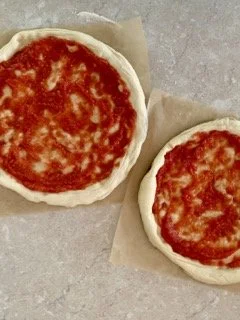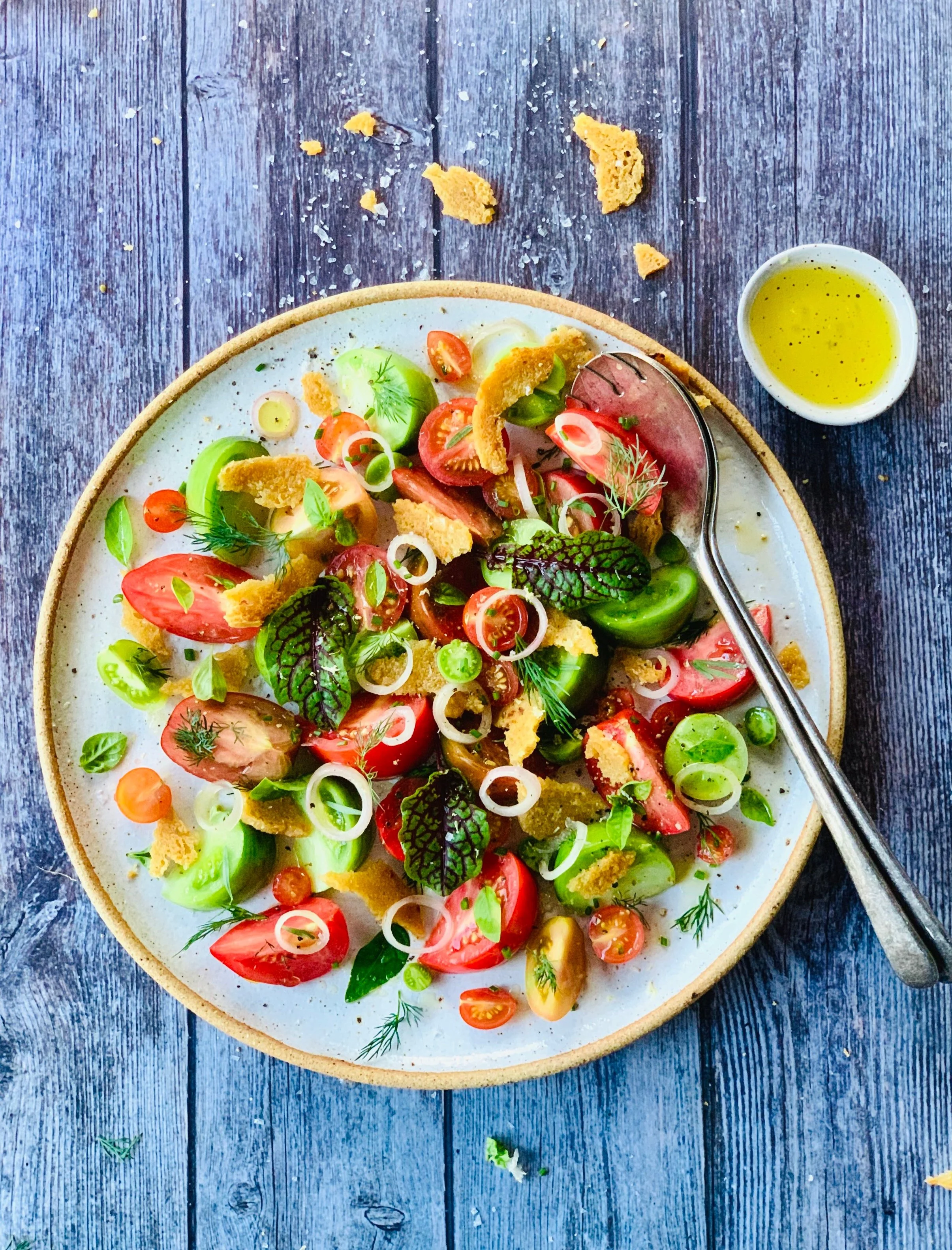Homemade "Wood Fire" Pizza
A crispy, chewy base that tastes like the real thing!
Unless you have a wood-fired pizza oven in your backyard, homemade pizza can be a disappointment. It's often soggy and not worth the effort. But good news! I've discovered a way to make homemade pizza that is nearly as good as what you'd get from your local pizzeria. All you need is a frying pan and an oven – no fire needed! The trick is to fry the pizza bases in a super-hot frying pan first. This means the base becomes nice and crispy with a touch of char, while the top of the dough puffs up, just like in a super-hot wood-fired oven. Add a few ingredients on top, bake for a few minutes in the oven, and you have yourself a delicious, chewy, crispy pizza in no time.
Before I stumbled upon this method, making pizza at home was a real challenge. No matter what I did, the base never cooked properly on the bottom, and my pizza ended up soggy. It was far from what you'd get at a pizzeria and didn't justify the effort. I discovered this method accidentally while making naan bread for my Bombay potato recipe – naan topped with cilantro and lime yogurt, then topped with spiced roasted potatoes and cilantro. The naan bread puffed up beautifully, and I had plenty left over, so I decided to use them to make pizzas for the kids' dinner that night. It turned out to be the best pizza I had ever made at home!
I quickly started experimenting with this idea. I tested regular pizza dough as well as a sourdough version, and while both were good, the naan base was the best. I think the key is that the naan recipe I use contains milk and egg, making it moister and chewier than a traditional base made with just water, flour, and yeast. This is particularly important for this recipe, as it's essentially cooked twice (on the stove and then in the oven), so a normal recipe dries out more than naan. If you are vegan or on the FODMAP-friendly diet and can't use this recipe, it is still super delicious using the traditional or sourdough (FODMAP-friendly) versions.
I'm super excited to bring you this recipe. It's by far my most tried and tested recipe ever. I've lost count of how many times I've made it. I never thought it was possible, but my kids actually got tired of eating pizza because I was making it so often! The good news is I think I've perfected the recipe. As with all pizza, it's important to stick with the Italian way of making pizza – nice thin bases, minimal toppings, and use a good-quality tomato base.
I use San Marzano canned tomatoes. These tomatoes are one of only two types considered authentic for making true Neapolitan pizza, and their production is protected under European designation of origin certification. You can easily buy Mutti-branded San Marzano tomatoes here in Australia, but honestly, all their canned tomato products are great for pizza. San Marzano tomatoes are double the price, so if you want a cheaper option, just buy Mutti finely diced tomatoes. Don't use passata; you want a little bit of texture in your tomatoes. No need to add any other ingredients to your tomato base – just chopped tomatoes; that's it! Salt and flavor come from the other ingredients you add. If you use whole tomatoes (San Marzano are usually sold whole), just use a hand blender to blitz them until they're finely chopped. If you want a white pizza (pizza bianca without tomato), I like to use a garlic herb oil instead of the tomato base.
Next, you'll want to use good-quality cheese. I just use mozzarella – make sure you grate it yourself and try not to buy pre-grated, as they add extra preservatives to it. If you're using fresh mozzarella such as fior di latte or buffalo mozzarella, make sure you drain it really well; otherwise, the extra water from using fresh cheese will make your pizza soggy. And no one wants a soggy pizza! The same goes for any other ingredients that have a high water content. I know it's a controversial subject, but if you put pineapple on your pizza (no judgment!), drain it and use a paper towel to remove any excessive liquid. The same goes for roasted capsicum (bell peppers) – one of my all-time favourite pizza toppings.
Now that we've covered the two most important ingredients, cheese and tomato, the rest is up to you. Just keep it simple. Add some fresh basil for a simple margherita. I like to use hard and buffalo mozzarella for a delicious, simple combo. My other favorite combo is pizza bianca with garlic herb oil, shaved zucchini and goat cheese, with fresh pesto and rocket on top after it's cooked. Serve with a nice fresh simple salad such as my Italian fennel coleslaw recipe (pictured below) or my pear, maple roasted pecan and rocket salad.
Homemade "Wood Fire" Pizza
Prep time: 90 minutes plus time for the dough to rise
Serves: Makes 5 traditional dinner plate sized pizzas
Dietary guide: This recipe is vegetarian but can easily be adapted to be vegan, GF or FODMAP friendly.
Vegan version: Use your favourite pizza dough recipe instead of the one provided here using the same pan frying method. Replace the cheese with vegan cheese or choose vegan whatever vegan toppings you like. Vegan pizza is always great topped with fresh vegan pesto!
FODMAP friendly version: Use your favourite sour dough pizza base and make sure your topi
Gluten free version: Use your favourite GF pizza dough recipe and use the same pan frying method here.
Ingredients
For the dough
3 3/4 cups (470g) of bread or plain white flour
2 1/2 teaspoons (7g) of instant yeast
1 tablespoon sugar
1/4 cup of milk
1 egg
1 tsp salt
Olive oil for pan frying
Handful of polenta for frying (optional)
Toppings for Margarita
1 can of chopped tomatoes (highly suggest using San Marzano canned tomatoes or the Mutti brand)
500g of mozzarella freshly shredded
Handful of fresh basil
Instructions
Mix the yeast, sugar, and 1 cup of warm water together. Let it sit for 10 minutes or until the yeast starts to bubble and foam.
Place the flour and salt in the bowl of a mixer with a dough hook or a bread machine. Add the yeast mix, the egg, and the milk, and knead for 10 minutes. Cover and let it sit for a couple of hours or until it has doubled in size.
Knock the dough back and divide it into 5 pieces. Roll them into balls, place them on a floured surface, and cover (I use a large bowl as a "lid").
After 30 minutes, flatten a ball of dough with your hand and roll it out to a plate-size circle (make sure it will fit your frying pan). Try to leave a higher rim of dough around the edge that will form the crust. I use my fingers to press down the dough everywhere but the edge. Repeat with all three balls.
Preheat your oven to 250 degrees Celsius (482 degrees Fahrenheit).
Heat a large frying pan over the highest heat setting. When it starts to smoke drizzle in a slosh of olive oil (about 2 teaspoons worth), scatter with a few inches of polenta if using and quickly and carefully transfer the dough into the pan (crust side up). After a few minutes, the dough should puff up. Use a spatula to check that the underside has turned golden, crunchy. When the base is ready, transfer to a pizza or baking tray, crust side up. Wipe the pan clean and repeat with the remains bases. Make surety pan is super hot before adding the dough.
Spread 1/5 of the canned tomatoes over the pizza base, scatter with basil and mozzarella, and bake in the oven for about 5 minutes. Repeat with the remaining bases and toppings. For the best results, only cook one pizza at a time.




























